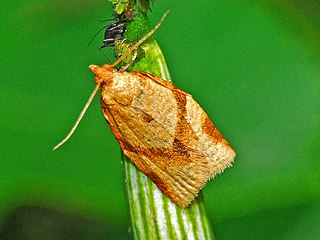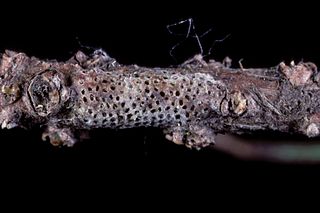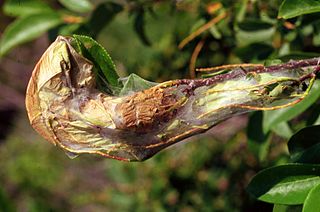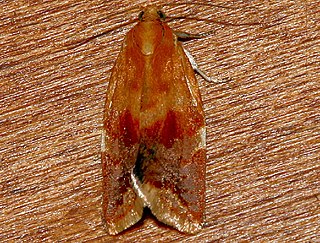
The Tortricidae are a family of moths, commonly known as tortrix moths or leafroller moths, in the order Lepidoptera. This large family has over 10,350 species described, and is the sole member of the superfamily Tortricoidea, although the genus Heliocosma is sometimes placed within this superfamily. Many of these are economically important pests. Olethreutidae is a junior synonym. The typical resting posture is with the wings folded back, producing a rather rounded profile.

The light brown apple moth is a leafroller moth belonging to the lepidopteran family Tortricidae.

Archips semiferanus is a species of moth in the family Tortricidae, and one of several species of moth commonly known as oak leafroller or oak leaf roller. The larvae feed on the leaves of oak trees in the eastern United States and southeastern Canada and are a major defoliator of oak trees, which can lead to tree mortality. In Pennsylvania in the late 1960s and early 1970s, oak leafrollers defoliated over 1,045,000 acres (423,000 ha).

Clepsis consimilana, the privet tortrix, is a moth of the family Tortricidae.

Epinotia tenerana, the nut bud moth or alder tortricid, is a moth of the family Tortricidae.
Cryptophlebia ombrodelta, the litchi fruit moth or macadamia nut borer, is a moth of the family Tortricidae. The species was first described by Oswald Bertram Lower in 1898. It is native to India, Sri Lanka, Nepal, Indonesia, China, Taiwan, Vietnam, Thailand, western Malaysia, New Guinea, the Philippines, Japan, Guam, the Caroline Islands, Australia and has been introduced to Hawaii.

Archips goyerana, the baldcypress leafroller, is a moth of the family Tortricidae.

Argyrotaenia franciscana, the orange tortrix or apple skinworm, is a moth of the family Tortricidae. It is found from California north to Oregon and Washington.

Proteoteras willingana, the eastern boxelder twig borer moth, is a moth of the family Tortricidae. It is found in southern Canada and the eastern United States, west through the Great Plains.

Archips cerasivorana, the ugly-nest caterpillar moth, is a species of moth of the family Tortricidae. The caterpillars of this species are known to create nests by tying the leaves of their host plant together. Within the nests, they live and feed off the leaves that have been tied together. The larvae are brownish or greenish yellow with a shiny dark brown head. Larvae can be found from May to July. The species overwinters as an egg, and pupation takes place within the nest. Caterpillars are seen follow one another in trails, a behavior prompted by the release of signaling pheromones from their spinnerets.
Archips machlopis is a moth of the family Tortricidae. It is widely distributed in southern Asia.

Homona coffearia, the tea tortrix or camellia tortrix, is a moth of the family Tortricidae. The species was first described by Nietner in 1861. It is widely distributed in the Oriental region.

Platynota flavedana, the black-shaded platynota moth, is a species of moth of the family Tortricidae. It is found in the United States from Minnesota to Maine, south to North Carolina and west to Arizona.

Cnephasia longana, the omnivorous leaftier moth, long-winged shade or strawberry fruitworm, is a moth of the family Tortricidae. It was described by Adrian Hardy Haworth in 1811. It is native to western Europe. It is an introduced species in western North America. The species has also been reported from north-western Africa and Asia. The habitat consists of downland and rough ground.
Archips alberta is a species of moth of the family Tortricidae first described by James Halliday McDunnough in 1923. It is found in North America, where it has been recorded across boreal Canada, south through the mountains to Utah. The habitat consists of coniferous forests.
Archips georgianus, the Georgia archips moth, is a species of moth of the family Tortricidae. It is found in North America, where it has been recorded from New Jersey, south to Florida and then west to Texas.

Archips purpuranus, the omnivorous leafroller moth, is a species of moth of the family Tortricidae. It is found in most of eastern North America.

Clepsis persicana, the white triangle tortrix or the green needleworm, is a species of moth of the family Tortricidae. It is found in North America, where it has been recorded from Alaska and British Columbia to Newfoundland and south to Virginia and west to California. The habitat consists of coniferous and mixed coniferous forests.
Spilonota albicana, the white fruit moth, larger apple fruit moth or eye-spotted bud moth, is a species of moth of the family Tortricidae. It is found in China, Korea, Japan and Russia. It has been accidentally introduced in the Netherlands.

Endothenia hebesana, the verbena bud moth, is a species of moth of the family Tortricidae. It is found in North America, where it has been recorded from Massachusetts, New York, New Jersey, Pennsylvania, Maryland, Virginia, North Carolina, Florida, Texas, Ohio, Indiana, Missouri, California, British Columbia, Alberta, Manitoba and Ontario. The habitat consists of black spruce-sphagnum bogs.
















